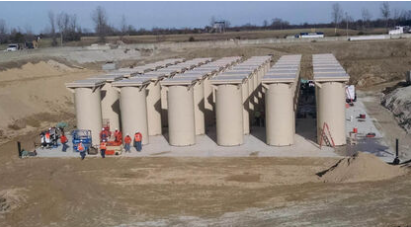
Spent nuclear waste will be routed to Lea County by rail if the federal government grants New Jersey based Holtec International a license to construct and operate its proposed HI-STORE CISF (consolidated interim nuclear storage facility) on a 1000-acre site located by the border of Lea and Eddy counties.
In July, the United States Nuclear Regulatory Commission (NRC) issued its final Environmental Impact Statement finding “no environmental impacts” to preclude the NRC from going forward with the project by granting a license to Holtec.
If the facility becomes a reality, spent nuclear fuel will be stored at the site in canisters weighing 200 tons each. The canisters will be transported from nuclear power plants throughout the US to Clovis, New Mexico “… to reach a rail line that is the only access route to the Lea County [spent nuclear waste] site, states an article published in the Eastern New Mexico News.
According to Holtec International’s program director Ed Mayer, no more than 10 canisters would be carried on a train, and the train would be “solely dedicated to spent fuel waste hauling”. Mayer stated in an article published at NMPoliticalReport.com that little risk exists during transport and that the canisters are “…strong enough to withstand a plane flying into them.”
Frequency of trains carrying nuclear waste to the Lea/Eddy counties site would be limited, with only one or two trains per month. All trains carrying nuclear waste, states Mayer, would be pulled by two locomotives as a safeguard. Should a locomotive break down the train could keep moving to its destination without interruption.
Trains would also be accompanied by armed guards, and both the United States Department of Transportation and the NRC would track each train throughout its journey.
Mayer comments that nuclear materials have been moved around the United States for 60 years “without incident”. Still, transporting canisters filled with spent nuclear waste safely to Lea County is a concern to many.
Safe Transport Concerns
Activist Paul Pino is vocal about his concerns about the Holtec project. Reflecting back to 1945 when the world’s first atomic bomb was detonated at a test site in New Mexico with the result of 36,000 acres of sand being fused like glass, Pino is quoted in a CurrentArgus.com article as stating, “The Nuclear industry is so dirty that no one knows what to do with the garbage. They know they want to send it to us. Who would keep producing garbage you can’t throw away?”
Pino is not the only opponent of Holtec’s proposed facility. A “rare combination of environmental and Indigenous activists, state government officials and oil and gas companies” do not support Holtec’s efforts. These opponents argue that “… the placement of the underground silos will impede the ability to drill [for oil and gas] in the area.” Effective oil and gas operations, as well as the safety of the industry’s workforce, are crucial to the well-being and economic growth of Lea County.
Lea County is not the only country asking questions about the Holtec project. Holtec representatives are on record as saying that they have met with police officials, firefighters and handlers of hazardous materials in 15 New Mexico counties. All of these counties could be impacted by the transport of the spent nuclear waste to the Holtec facility or by the facility itself. About these stakeholders Mayer said, “They have a lot of questions, but when we leave, they have no concerns.”
How perceptive Mayer is about stakeholders’ true opinions is unknown. As previously reported by the Lea County Tribune, both New Mexico Governor Michelle Lujan Grisham and Texas Governor Republican Greg Abbott oppose the Holtec project. The state’s Attorney General Hector Balderas filed a lawsuit in 2021 against the NRC to halt the project.
New Mexico Sen. Jeff Steinborn (Dem. – Dist. 36) also opposes the project. He objects to the fact that the facility is being licensed as a “temporary” facility, although no “…repository [is] even being planned in America.” Steinborn reasons that “temporary” could become “permanent”. Stienborn sees the risks of canister failure and the dissolution of Holtec as profound. “That’s the equivalent of throwing New Mexico over a cliff with no net,” he said.
Mayer’s official response from Holtec to Steinborn’s concerns also appears rather cavalier. Mayer said, “40 years should be adequate for finding, licensing and constructing a permanent spent fuel repository.”
Photo by Eastern New Mexico News – Canisters like the ones that would be transported to the proposed Holtec site.


